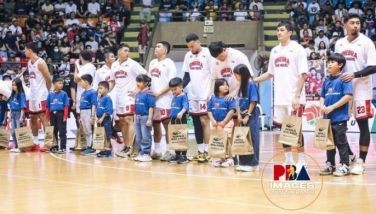Fearless forecasts
MANILA, Philippines - These days, the joke is no longer about forecasts that turn out to be the exact opposite of what the weather is. With improved equipment and training to interpret data gathered, forecasts have become more accurate, from amount of rainfall to when a typhoon will hit.
For the country’s weather forecasters, the biggest challenge is not so much making accurate forecasts but relaying the warnings in such a way that they are easily understood and followed by the public in order to save lives and property.
Living in a typhoon-prone country like the Philippines, it is imperative that Filipinos understand the information coming from the weather bureau to be able to prepare for potentially deadly hazards like flooding, landslides, storm surges and power outages.
“Our biggest challenge as forecasters is how to make people believe and heed our warnings,” Renito “Rene” Paciente, assistant weather services chief of the Philippine Atmospheric, Geophysical and Astronomical Services Administration (PAGASA), tells STARweek.
He recalls the time he was forced by his boss to give an interview on the weather update to a Manila-based radio station. He was nervous because he thought he would fumble with his thick Visayan accent – and he did.
“Because of my nervousness that time, instead of saying, ‘ang dagat ay magiging mahina hanggang sa katamtaman ang pag-alon (the seas will be slight to moderate),’ I said, ‘ang dagat ay magiging maalat (the seas will be salty),’ and everybody in the weather forecasting laughed,” he recalls.
Now the agency has all forecasters giving live radio and TV interviews.
“It (live interview) is our way of training them. Because when they report live they will learn on their own, they will study the forecast well,” the 57-year-old Paciente explains.
When a forecaster reports for duty at the Weather and Flood Forecasting Center in Quezon City, their first order of business is to observe and interpret vast amounts of data, including satellite imagery, surface data and rainfall reports.
Forecaster Aldczar Aurelio says knowledge of what the public needs from a weather forecast must always be taken into account.
“First, I try to report the weather as if I am talking to a friend. Second, I think of what the people would like to know. Will it rain? Is it going to flood in my area? When will the rainy season or summer start? As much as possible, I try to avoid using technical terms,” the 33-year-old Aurelio says.
For forecaster Jori Loiz, the weather forecasts must be explained in the simplest terms that can be easily grasped by a Filipino who has not reached high school.
“What we report will affect the people’s lives, that’s why we have to explain it in a way that even a Grade 1 student can understand,” he says.
The forecasters said they are more confident now in doing live TV and radio interviews.
“Before I wanted to impress the news anchors so I used more technical terms, but I realized that even if I made long explanations they could not understand what I’m saying, so I started explaining the forecast in simple language,” Loiz says.
PAGASA regularly conducts basic broadcasting seminars to enhance the communication skills of the forecasters.
The agency also conducts annually a seminar workshop for the media, where journalists learn weather terminologies and PAGASA operations.
‘Brain drain’
Paciente admits the departure of seasoned forecasters is a challenge for the weather agency.
At present, the agency has 14 weather forecasters, three of whom are women. The forecasters work in three shifts, according to Paciente.
“We need more forecasters, especially during severe weather disturbances,” he says.
Ramon Agustin, president of the PAGASA Weather Employees Association, said 32 of their employees, mostly weather forecasters, have left the country for better-paying jobs abroad since 2005.
This year alone, at least three forecasters left the Philippines to work in Qatar, he said.
Paciente said the PAGASA management should conduct a meteorological training course so they can hire new forecasters. The last time the agency conducted the training was in 2012.
Paciente says PAGASA personnel have to undergo rigid training before becoming forecasters.
“The experience of the forecasters is invaluable,” says Aurelio, who has been serving the PAGASA for nine years.
However, he says he could not blame the forecasters who choose to leave the agency for greener pastures.
The forecasters say they did not dream of becoming weather forecasters when they were young.
Aurelio, a graduate of electronics and communication engineering from the Polytechnic University of the Philippines-Sta. Mesa campus, said he wanted to work in telecommunication companies.
But his father, a former PAGASA employee, convinced him to apply at the weather bureau, citing the better benefits being provided to state workers.
Loiz, 50, was a former employee at the Municipal Engineers Office of Balagtas, Bulacan and is a chemical engineering graduate.
Paciente, who has been with PAGASA for 29 years, is an agricultural engineering graduate of De La Salle Araneta University.
He says to become a forecaster, he or she has to have a strong background in mathematics and physics, and good communication skills.
‘15 in 2016’
The recent onslaught of Typhoon Glenda showed how state-of-the-art equipment and proper communication in the agency helped reduce casualties and damage to property.
“The Doppler radars really helped us a lot. We have accurately predicted the movement and location of Glenda. We even indicated the municipality where the eye is located,” Paciente says.
“Our hourly forecasts of Typhoon Glenda were spot-on,” he adds with justifiable pride.
The country currently has 10 Doppler radars located in Aparri, Cagayan; Baguio City; Baler, Aurora; Subic, Zambales; Tagaytay City; Virac, Catanduanes; Cebu City; Guiuan, Eastern Samar; Hinatuan, Surigao del Sur; and Tampakan, Cotabato.
The Aquino government aims to install five more Doppler radars by 2016 in Iloilo, Zamboanga, Batanes and two in Palawan.
Paciente says the advantage of a Doppler radar over satellite is that it can also provide the estimated rainfall amount that will be dumped by a weather disturbance.
Paciente laments that despite dire warnings of strong winds and heavy rains from Glenda, there were those who did not leave their residences.
“Our biggest challenge is how to convince the public to listen to the warnings coming from PAGASA and the local government units. Because our problem is there are people who still refuse to be evacuated. If they only follow our or the LGUs’ advice, there would have no casualties,” he says.
Forecaster Christopher Perez says disaster preparedness is a collective effort and not just the sole responsibility of the government and the weather service provider.
“No matter how good is our forecast, if people will not heed our warnings, we cannot assure that we will meet our target of zero casualty or zero damage,” the 36-year-old Perez underscores.
- Latest
- Trending


















